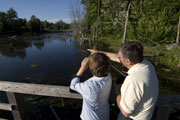2. Hampton Town Hall
27 Centennial Road (trail is behind the parking lot)

Known for its expansive beds of wild rice, Zizania americana, the Kennebecasis River might deservedly be referred to as the River of Rice. The origins of this rich-water plant are still a bit of a mystery. Was the plant in use by the First Nations during the earliest of times or did Europeans bring the seeds?
These rice laden marshes attract an impressive number of Wood Ducks, or Aix sponsa, who come here to nest in the spring, molt in the summer, and roost in the early autumn. Post-breeding male Woodies push out new flight feathers after their ‘beautiful brides’ (the English translation of Aix sponsa) have all but forgotten their amorous advances of only a few short weeks ago. The locally breeding Wood Duck males are joined by their brethren from places south of the border. This is one of a few species whose males make a northern migration to molt in the emergent and shrub wetlands of New Brunswick. Come late August, the birds fatten up on the river rice, in preparation for a migration that will commence around the middle of October. These prized game birds live in the collective memory of thousands of river fishermen. During the cold winter months, these aficionados put in countless hours at their basement workbenches crafting the birds’ flank feathers into integral ‘flashing material’, in hopes of creating the perfectly deceptive imitation flies deployed on rivers named Restigouche, Miramichi, and the Hammond River, local tributary of the Kennebecasis, where these are laid by the noses of the king of game fish, the mighty Atlantic Salmon.
At the back of Hampton Town Hall you take the trail upriver along Ossekeag Creek, an expansive wetland tributary that flows into the Kennebecasis. This emergent wetland is rich in nutrients that flow out into the main stem of the river feeding a freshwater delta of soft riverbanks and a massive emergent wetland complex that commences at Hampton. In this delta, nutrients are churned by tidal action and rain events, eventually flowing out through the reversing falls at Saint John to culminate in the nourishment of seabirds and whales in the species-rich Bay of Fundy. The Maritime directional references, upstream and downstream, make visualizing environmental impacts easy.
Ossekeag Creek Marsh is a fertile wetland that attracts the Northern Shoveler, known to children who have participated in wetland education programs as the spoonbill duck. The American Widgeon plays here too. You can hear his robin-like whistles throughout the breeding season. In the open water sections of the marsh, bright yellow broods of Wood Ducks slice their way through the Lemna minor covered waters searching for the protein that will frame their rapidly growing bodies. Water birds and wading birds are also attracted to this wetland. Pied-billed grebe dive silently underwater and disappear if approached too closely. But the Great-Blue Heron is accustomed to visitors and will let you get close enough for a look at its six foot wide wingspan. Somehow, 1.85 meters just doesn’t do these giant prehistoric-looking birds with the stick legs any justice.
In the floodplain forest that surrounds the wetland you might hear the tapping of a Hairy Woodpecker, working diligently to flip off the delicately raised slivers of bark from a dying Silver Maple. You might even catch a glimpse of the large but inconspicuous Northern Water Thrush. Darting from the fringe trees of the marsh and fields is one of the first avian immigrants to have come to this new land, the European Starling. Just when the purists begin to think this is just another darling place infested with the purple-chested and flecked blackbirds, you see him, a marriage of olive drab and bright yellow, a Great Crested Flycatcher, brings you back to the special natural experience this place has to offer.